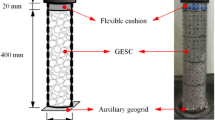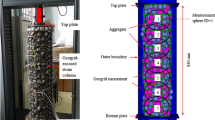Abstract
An innovative method for modeling a complicated geotechnical problem combining the coarse and fine zones is to use the hybrid methods. The granular zone of a geotechnical system can be modeled by the discrete element method (DEM) and the fine zone by continuum-based methods. The advantage of this approach is the use of the capabilities of both methods. In the present research, by combining DEM and finite difference method (FDM), a 2D numerical laboratory framework is constructed. Simulation of a vertically loaded stone column installed in clay was chosen to examine the capabilities of the present approach. The contrast between the stone column aggregates, which usually consist of crushed stone with distinct behavior, and the host medium, which is clay with continuum behavior, makes the stone column suitable for this kind of coupled simulation. The coupled numerical model is validated by comparing the load–settlement response of the numerical model and the reported experimental results. Afterward, the failure mechanism of the stone column is evaluated. The column bulging was captured properly, and it was found that in addition to the bulging, the contraction occurs at the upper portion of the column. It was also found that at the early stages of loading, the compaction occurs in the column. However, at later stages of loading, the bulging will happen. Furthermore, the results showed that bulging decreases the internal stresses of the column. All of these achievements were obtained by micro and macro investigations. The obtained results indicate that the coupled DEM–FDM method is a robust approach to simulate the behavior of some geotechnical problems.


















Similar content being viewed by others
References
Almeida MSS, Hosseinpour I, Riccio M, Alexiew D (2014) Behavior of geotextile-encased granular columns supporting test embankment on soft deposit. J Geotech Geoenviron Eng 141(3):04014116
Asadi M, Mahboubi A, Thoeni K (2018a) Discrete modeling of sand–tire mixture considering grain-scale deformability. Granul Matter 20(2):18
Asadi M, Thoeni K, Mahboubi A (2018b) An experimental and numerical study on the compressive behavior of sand–rubber particle mixtures. Comput Geotech 104:185–195
Barksdale RD, Bachus RC (1983) Design and Construction of Stone Columns Volume II, Appendixes. Federal Highway Administration, Washington
Belytschko T, Xiao SP (2003) Coupling methods for continuum model with molecular model. Int J Multiscale Comput Eng 1(1):1–12
Breugnot A, Lambet S, Villard P, Gotteland P (2016) A discrete/continuous coupled approach for modeling impacts on cellular geostructures. Rock Mech Rock Eng 49(5):1831–1848
Broughton JQ, Abraham FF, Bernstein N, Kaxiras E (1999) Concurrent coupling of length scales: methodology and application. Phys Rev B 60(4):2391
Cundall, P. A. (1971). A computer model for simulating progressive large scale movements in blocky rock systems. In Proceedings of the Symposium of International Society of Rock Mechanics, vol. 1, Nancy: France; Paper No. II-8.
Cundall PA (1987) Distinct element models of rock and soil structure. In: Brown ET (ed) Analytical and Computational Methods in Engineering Rock Mechanics. Allen & Unwin, London, pp 129–163
Cundall PA, Strack OD (1979) A discrete numerical model for granular assemblies. Geotechnique 29(1):47–65
Cundall PA, Hart RD (1992) Numerical modelling of discontinua. Eng Comput 9(2):101–113
Deb K, Behera A (2017) Rate of consolidation of stone column-improved ground considering variable permeability and compressibility in smear zone. Int J Geomech 17(6):04016128
Duan N, Cheng YP, Liu JW (2018) DEM analysis of pile installation effect: comparing a bored and a driven pile. Granul Matter 20(3):36
Elmekati A, Usama ES (2010) A practical co-simulation approach for multiscale analysis of geotechnical systems. Comput Geotech 37(4):494–503
Elsawy MBD (2013) Behaviour of soft ground improved by conventional and geogrid-encased stone columns, based on FEM study. Geosynth Int 20(4):276–285
Eskandari M, Shodja HM, Ahmadi SF (2013) Lateral translation of an inextensible circular membrane embedded in a transversely isotropic half-space. Eur J Mech A Solids 39:134–143
Ferellec JF, McDowell GR (2010) A method to model realistic particle shape and inertia in DEM. Granul Matter 12(5):459–467
Ghazavi M, Nazari Afshar J (2013) Bearing capacity of geosynthetic encased stone columns. Geotext Geomembr 38:26–36
Goodman RE, Taylor RL, Brekke TL (1968) A model for the mechanics of jointed rock. J Soil Mech Found Div 94(3):637–659
Hamidi M, Lajevardi SH (2018) Experimental study on the load-carrying capacity of single stone columns. Int J Geosynth Ground Eng 4(3):26
Han J (2015) Principles and Practice of Ground Improvement. Wiley, New Jersey
Hart R, Cundall PA, Lemos J (1988) Formulation of a three-dimensional distinct element model Part II. Int J Rock Mech Min Sci Geomech Abstr 25(3):117–125
Hosseinpour I, Riccio M, Almeida MSS (2014) Numerical evaluation of a granular column reinforced by geosynthetics using encasement and laminated disks. Geotext Geomembr 42(4):363–373
Indraratna B, Ngoc TN, Rujikiatkamjorn C, Sloan SW (2015) Coupled discrete element–finite difference method for analysing the load-deformation behaviour of a single stone column in soft soil. Comput Geotech 63:267–278
Kirsch F, Kirsch K (2016) Ground Improvement by Deep Vibratory Methods. CRC Press, Boca Raton
Lu M, McDowell GR (2007) The importance of modelling ballast particle shape in the discrete element method. Granul Matter 9(1–2):69
Mahabadi OK, Lisjak A, Munjiza A, Grasselli G (2012) Y-Geo: new combined finite-discrete element numerical code for geomechanical applications. Int J Geomech 12(6):676–688
Mazumder T, Rolaniya AK, Ayothiraman R (2018) Experimental study on behavior of encased stone column with tyre chips as aggregates. Geosynth Int 25(3):259–270
Murugesan S, Rajagopal K (2006) Geosynthetic-encased stone columns: numerical evaluation. Geotext Geomembr 24(6):349–358
Murugesan S, Rajagopal K (2007) Model tests on geosynthetic-encased stone columns. Geosynth Int 14(6):346–354
Ngo NT, Indraratna B, Rujikiatkamjorn C, Biabani M (2015) Experimental and discrete element modeling of geocell-stabilized sub ballast subjected to cyclic loading. J Geotech Geoenviron Eng 142(4):04015100
Otsubo M, O’Sullivan C, Shire T (2017) Empirical assessment of the critical time increment in explicit particulate discrete element method simulations. Comput Geotech 86:67–79
Padrón LA, Aznárez JJ, Maeso O (2007) BEM–FEM coupling model for the dynamic analysis of piles and pile groups. Eng Anal Bound Elem 31(6):473–484
Potyondy DO, Cundall PA (2004) A bonded-particle model for rock. Int J Rock Mech Min Sci 41(8):1329–1364
Rui R, van Tol F, Xia XL, van Eekelen S, Hu G, Xia YY (2016) Evolution of soil arching; 2D DEM simulations. Comput Geotech 73:199–209
Sharma RS, Phanikumar BR (2005) Laboratory study of heave behavior of expansive clay reinforced with geopiles. J Geotech Geoenviron Eng 131(4):512–520
Shodja HM, Ahmadi SF, Eskandari M (2014) Boussinesq indentation of a transversely isotropic half-space reinforced by a buried inextensible membrane. Appl Math Model 38(7–8):2163–2172
Siahaan, F., Indraratna, B., & Rujikiatkamjorn, C. Three dimensional modelling of the behaviour of stone columns using the discrete element method. In Proceedings of the TC105 ISSMGE International Symposium on Geomechanics from Micro to Macro, IS-Cambridge 2014, Vol. 1, 553–558.
Sivakumar V, Jeludine DKNM, Bell A, Glynn DT, Mackinnon P (2011) The pressure distribution along stone columns in soft clay under consolidation and foundation loading. Géotechnique 61(7):613–620
Tan X, Zhao M, Wei C (2018) Numerical simulation of a single stone column in soft clay using the discrete-element method. Int J Geosynth Ground Eng 18(12):04018176
Tran QA, Chevalier B, Breul P (2016) Discrete modeling of penetration tests in constant velocity and impact conditions. Comput Geotech 71:12–18
Tsuji Y, Kawaguchi T, Tanaka T (1993) Discrete particle simulation of two-dimensional fluidized bed. Powder Technol 77(1):79–87
Zhang L, Zhao M (2015) Deformation analysis of geotextile-encased stone columns. Int J Geomech 15(3):04014053
Zhongzhi F, Shengshui C, Sihong L (2016) Discrete element simulations of shallow plate-load tests. Int J Geomech 16(3):04015077
Author information
Authors and Affiliations
Corresponding author
Additional information
Publisher's Note
Springer Nature remains neutral with regard to jurisdictional claims in published maps and institutional affiliations.
Rights and permissions
About this article
Cite this article
Gholaminejad, A., Mahboubi, A. & Noorzad, A. Hybrid Continuous-Discrete Modeling of an Ordinary Stone Column and Micromechanical Investigations. Geotech Geol Eng 39, 3249–3264 (2021). https://doi.org/10.1007/s10706-021-01692-4
Received:
Accepted:
Published:
Issue Date:
DOI: https://doi.org/10.1007/s10706-021-01692-4




